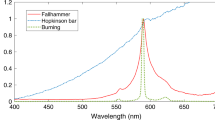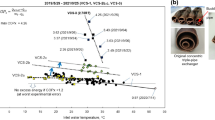Abstract
TRUE detonation in high explosives normally gives as the major products gases such as carbon dioxide and monoxide, water, nitrogen and hydrogen1,2, the relative quantities obtained being in general accordance with calculations based on equilibrium considerations. The thermal decomposition of explosives, on the other hand, gives more complicated products such as nitrogen oxides, aldehydes and complex condensation products, which may undergo further secondary reactions3,4. It was of interest to see whether the products from impact-initiated explosions would approximate more closely to those of detonation or thermal decomposition. Results with the two nitric esters, nitroglycerin and pentaerythritol tetranitrate, and the nitroamine, cyclo-trimethylenetrinitramine, reveal an intermediate behaviour. The figures are given in the accompanying table. The impacts were carried out in a vacuum apparatus5. For comparison, some figures for the explosive decomposition of nitroglycerin and pentaerythritol tetranitrate are quoted.
This is a preview of subscription content, access via your institution
Access options
Subscribe to this journal
Receive 51 print issues and online access
$199.00 per year
only $3.90 per issue
Buy this article
- Purchase on Springer Link
- Instant access to full article PDF
Prices may be subject to local taxes which are calculated during checkout
Similar content being viewed by others
References
Robertson, R., and Garner, W. E., Proc. Roy. Soc., A, 103, 539 (1923).
Haid, A., and Schmidt, A., Z. ges. Schiess- u. Sprengstoffw., 26, 253, 293 (1931).
Robertson, R., J. Chem. Soc., 95, 1241 (1909).
Appin, A., Chariton, J., and Todes, O., Acta Physiochim. U.R.S.S., 5, 655 (1936).
Yoffe, A., Nature, [161, 349 (1948)].
Taylor, J., and Hall, C. R. L., J. Phys. Coll. Chem., 51, 593 (1947)
Bowden, F. P., and Gurton, O. A., Nature, [161, 348 (1948)1.
Author information
Authors and Affiliations
Rights and permissions
About this article
Cite this article
ROBERTSON, A., YOFFE, A. Gases Liberated from Explosions Initiated by Impact. Nature 161, 806–807 (1948). https://doi.org/10.1038/161806a0
Issue Date:
DOI: https://doi.org/10.1038/161806a0
This article is cited by
-
A Split Hopkinson Pressure Bar Investigation of Impact-Induced Reaction of HMX, RDX and PETN
Journal of Dynamic Behavior of Materials (2023)
-
Decomposition of solid explosives by laser irradiation: A mass spectrometric study
Journal of Materials Science (1987)
-
Size Effects in the Initiation and Growth of Explosion
Nature (1953)
Comments
By submitting a comment you agree to abide by our Terms and Community Guidelines. If you find something abusive or that does not comply with our terms or guidelines please flag it as inappropriate.



